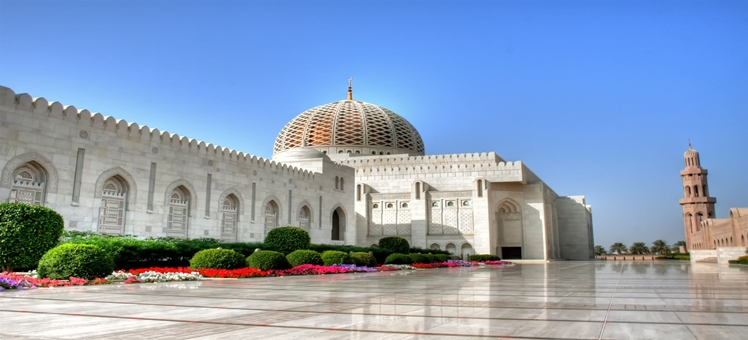
From glittering coastal cities to remote desert outposts, Oman packs in uniquely varied landscapes and climates into a relatively small landmass. The culture too changes distinctly from place to place – Muscat’s affluent urbanites, the Bedouin of the desert interior, the independent groups of the northern Musandam region. With so many contrasts, it can be hard to pin down the essence of Oman, but perhaps it is simply the hospitality of the people, eager to show you the best of their corner of this diverse country.
MuscatMuscat is a city of majestic beauty; its whitewashed buildings elegant and dazzling beneath a blindingly blue sky set against craggy mountains. Start in the Walled City, where the fortified stone gates provide a dramatic entry. Here, you’ll discover the Sultan’s Palace, an incongruously blocky art-deco building painted in flamboyant blue and yellow. For sublime Arabian architecture, visit the Grand Mosque – impressive enough outside, but jaw-dropping inside, with its gigantic chandelier, dripping with Swarovski crystals, and the largest prayer carpet in the world. Take in the view at the Muttrah Corniche, the harbor, and wander in the intoxicating, maze-like souq, which comes alive in the evening.
Nizwa
Once a fortress in the desert, Nizwa has grown into one of Oman’s most important cities. In Nizwa itself, the main attraction is the vast, sand-colored fort. Climb to the parapets to take in the views of the surrounding date plantations and mountains. The city’s souq is a true Aladdin’s Cave, crammed with pottery, food produce, clothing – and goats. Head out of the city to nearby Bahla, the center of the pottery craft and home to Oman’s oldest fort. Jebel Akhdar, meanwhile, is a mountain which benefits from more humid air. Pomegranates and apricots are cultivated on the green terraces, while the mountainside villages produce Oman’s famous rosewater.
Salalah
Far in the south of Oman, Salalah comes the closest Arabia has to a tropical paradise. In Monsoon season, known here as the Khareef, the Dhofar region is transformed into a lush, green land, where coconuts and bananas grow. Once you’ve relaxed on the beach, visit the impressive ancient fort at Al Baleed, once an important port. The region’s greatest claim to fame, however, is the almost-mythical frankincense, squeezed from the sap of the native scrubby trees. Take a trip along the Frankincense Trail to see the process in action, then visit the Al Husn souq where you can purchase the triple whammy: Gold, Frankincense and Myrrh.
Khasab
Enticingly remote, jutting out on Oman’s northernmost peninsula at the tip of the UAE, Khasab is like nowhere else in the country. Its fjord-like landscape, dramatic mountains rising from narrow sea channels, provides an incredible backdrop for boat trips and scuba diving. Better yet, the local dhow captains appear to have made friends with the local dolphins, who provide stellar leaping and diving exhibitions. To get even closer, head out on a kayak or don scuba gear and plunge beneath the waves to discover a whole host of underwater life. Back on dry land, visit the city’s fort and learn about Khasab’s independent history.